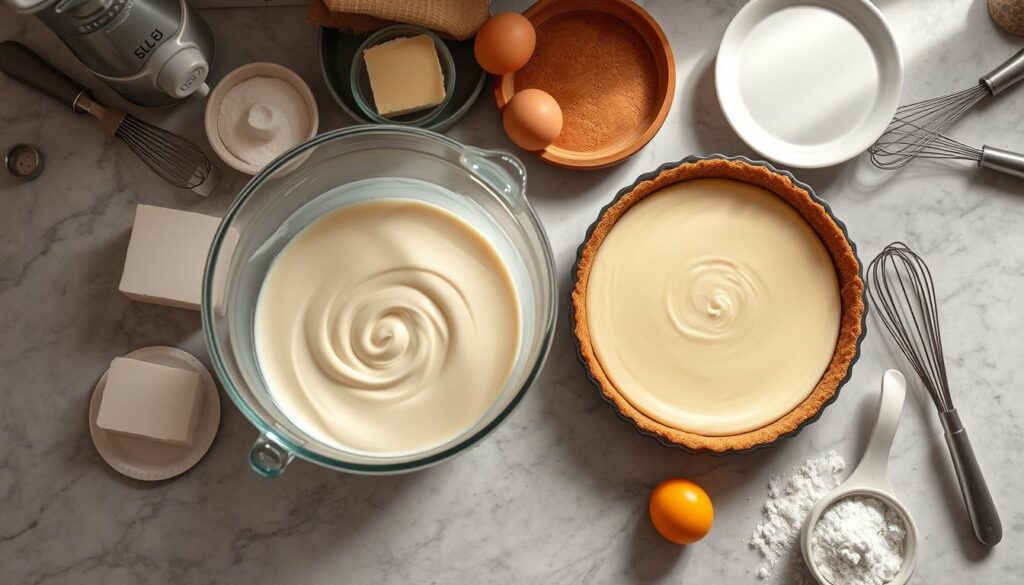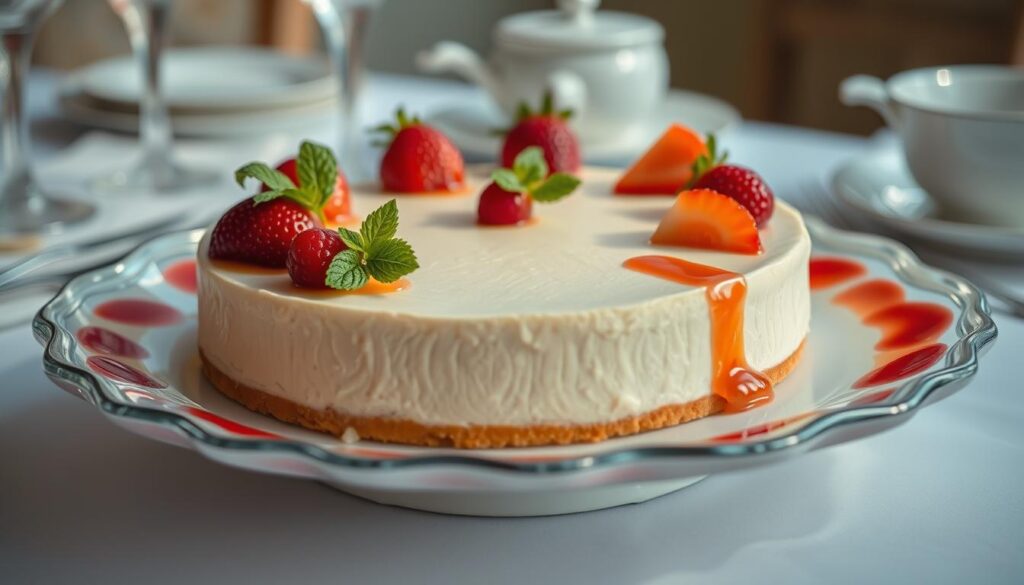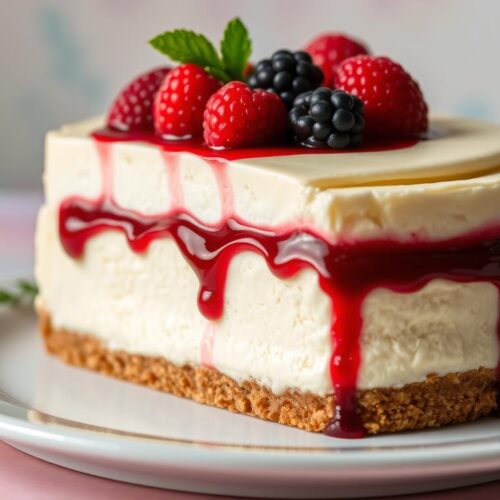Every creamy swirl of a Philadelphia cheesecake carries a story. It’s a moment of indulgence, a celebration, or a comforting embrace after a long day. For many, the Philadelphia cheesecake recipe is not just about the mix of sugar, cream cheese, and eggs. It’s a classic dessert filled with nostalgia and warmth. Mixing, pouring, and baking turn into a simple dance, creating a dessert rich with memories.
This recipe welcomes baking beginners and experts to enjoy making a truly creamy cheesecake. The key is the velvety full-fat Philadelphia cream cheese. Its distinct taste and texture blend perfectly with granulated sugar and eggs. This offers not just a dish, but an experience. It’s easy to prepare and unforgettable.
Key Takeaways
- The Philadelphia cheesecake recipe is a timeless classic dessert treasured for its creamy texture.
- Combining a simple graham cracker crust with a rich and velvety cream cheese filling defines this quintessential cheesecake.
- With minimal ingredients and user-friendly steps, creating a creamy cheesecake at home is remarkably easy.
- Quality ingredients, particularly full-fat Philadelphia cream cheese, are essential for achieving the perfect creamy consistency.
- The joy of making and sharing a Philadelphia cheesecake goes beyond taste, encapsulating personal reflections and shared moments.
Introduction to the World-Famous Philadelphia Cheesecake
The Philadelphia cheesecake is classic and iconic. Its velvety texture and rich flavor bring joy to many. Every slice tells a story of culinary excellence. The secret? The star ingredient in many Philadelphia cream cheese recipes.
Discovering the History Behind the Classic Dessert
The journey of Philadelphia cheesecake is as rich as its taste. It has evolved from ancient times to modern kitchens. Once simple and savory, the addition of Philadelphia cream cheese turned it into a beloved classic dessert worldwide.
Why Philadelphia Cream Cheese is Key to Creaminess
Philadelphia cream cheese brings creaminess to the cheesecake. It’s the key for that luxurious feel. This ingredient boosts flavor and ensures every bite is smooth, essential in many recipes.
Ingredients for a Luscious Philly Cheesecake
Creating irresistible decadent desserts begins with the right cheesecake ingredients. A creamy Philadelphia cheesecake stands out for its rich texture and deep flavor. Each part, from the crust to the filling, is key.
Essentials for the Perfect Graham Cracker Crust
A great cheesecake starts with a graham cracker crust. It’s the first taste of delight, offering a sweet and crunchy contrast to the smooth filling. The crust combines crushed graham crackers and melted butter. This mix ensures it stays together and tastes great.
| Ingredient | Amount | Description |
|---|---|---|
| Graham Cracker Crumbs | 1 and 1/2 cups | Finely ground, provides sweetness and texture |
| Unsalted Butter | 1/3 cup | Melted, binds the crumbs together |
| Sugar | 3 tablespoons | Adds a hint of sweetness |
| Salt | Pinch | Enhances the flavors |
Top-Quality Cream Cheese and Other Filling Ingredients
The filling brings Philly cheesecake to life. It features smooth, rich Philadelphia cream cheese as its heart. Eggs, sugar, and vanilla extract are added for a velvety texture loved by many. These ingredients make the cheesecake luxurious and delicious.

- Cream Cheese – The star of the show, providing a creamy dense texture
- Sugar – Balances the tanginess of the cheese and enhances sweetness
- Eggs – Helps thicken the filling, creating a smooth, rich consistency
- Vanilla Extract – Adds a depth of flavor, complementing the cream cheese beautifully
Making a memorable Philadelphia cheesecake means getting every ingredient right. From a sweet graham cracker crust to a creamy filling, the best cheesecake ingredients matter. Quality and precision in every step ensure a truly luxurious dessert experience, making it a favorite among decadent desserts.
Step-by-Step Guide to Making a Philadelphia Cheesecake Recipe
Starting your quest to make the perfect Philadelphia cheesecake? Begin with the crust. Mix graham cracker crumbs with melted butter. Then press it firmly into the base of a 9-inch springform pan. This forms a solid bottom that’s crucial for your easy cheesecake recipe.
Now, let’s talk about the filling. Mix softened Philadelphia cream cheese with sugar until smooth. Carefully mix at medium speed to avoid air bubbles. This helps prevent cracks. After blending sugar and cream cheese, add eggs one at a time. Stir gently after each egg until just mixed in.
Want to add a special twist? Try a Churro Cheesecake recipe. It brings a cinnamon taste that goes well with the creamy Philadelphia cheesecake.
When it’s time to bake, precision is key. Bake in a preheated oven until the center is set but still wobbles a bit. This ensures the eggs cook well, making the cheesecake smooth and rich.
Follow these steps for a Philadelphia cheesecake that’s both delicious and beautiful. Enjoy the journey and the creamy, luxurious dessert you create.
The Secret to a Flawless Creamy Cheesecake Texture
Getting that perfect creamy cheesecake texture is key in many dessert recipes. Enthusiasts and pro bakers work hard to perfect their mixing. This effort helps them get that smooth, luxurious feel.

Good mixing techniques help avoid common mistakes. These errors could ruin what might be an amazing dessert. It’s important not to rush or mix too hard.
Mixing Techniques to Avoid Overbeating
Mixing ingredients right and at the right speed is critical. Overbeating adds too much air, causing cracks as the cheesecake bakes. A softer mixing approach helps get everything just right. It keeps the cheesecake dense yet fluffy, the way it should be.
The Role of Eggs in Cheesecake Consistency
Eggs are vital in making sure the cheesecake mix is smooth. But, add them one by one, with gentle mixing. If you mix too much, the texture won’t be as velvety.
Mastering these mixing methods can really improve your desserts. They make every creamy cheesecake just perfect. Learn more about delightful and simple desserts that make your baking shine.
Baking Tips for the Ideal Cheesecake
Want the perfect cheesecake? Knowing the right baking tips is key. Whether it’s Philadelphia or New York style, we’ve got you covered. Here, you’ll find useful advice to make your cheesecake dream a reality.
Preventing Common Baking Issues
Cracks in cheesecake are a common issue. But, you can avoid them. Here’s how:
- Keep the oven temperature gentle. Too hot, and your cheesecake might crack.
- A water bath helps with even baking. By putting your cheesecake pan in another pan with hot water, you stop cracks.
- Try not to open the oven too much. Temperature changes can cause cracks.
Follow these tips for a smooth cheesecake top. You’ll improve the cheesecake’s texture, making it bakery quality.
Why Oven Temperature Matters
The right temperature is key for cheesecakes. It helps with the texture and keeps the cake stable. Let’s dive into why:
- A steady, low temperature cooks the cheesecake evenly. This prevents the edges from overbaking.
- If you’re using a dark pan, drop the temperature by 25 degrees Fahrenheit. It keeps the edges from cooking too fast.
- Using an oven thermometer ensures the correct temperature. This helps your cheesecake bake perfectly.
By baking carefully, your cheesecake will rise evenly without falling. This is true for both Philadelphia and New York styles.
Cooling & Serving: The Finish Line for Your Cheesecake
Every classic dessert needs a grand finale. Cooling and serving Philadelphia cheesecake the right way is key. This ensures it keeps its shape and tastes amazing. It makes the dessert a hit at gatherings.
Best Practices for Cooling Cheesecake
Cooling your cheesecake right is as important as baking it. First, let it stay in the off oven, door ajar, to avoid cracks. Then, let it cool on a wire rack at room temperature. This careful cooling keeps the cheesecake’s texture silky smooth.
How to Present Your Philadelphia Cheesecake
Serving your cheesecake beautifully makes it stand out. Loosen it from the pan with a knife. Then cut with a warm, dry knife for clean slices. These slices will show off the cheesecake’s creamy texture.
To decorate, try these tips:
- Add whipped cream on each slice.
- Top with fresh berries or fruit sauce for extra color and taste.
- Mint leaves add a fresh touch, enhancing the cheesecake’s flavor.

Good presentation is all about simplicity and elegance. Let your cheesecake’s natural allure shine.
Using these presentation tips and baking tips makes your cheesecake not just tasty but also eye-catching. This makes it unforgettable at any event.
Adapting the Recipe: Variations & Dietary Modifications
Cheesecake enthusiasts who want healthier options or need to meet dietary requirements can find solace. Our Philadelphia cheesecake can become a gluten-free cheesecake without losing its delightful taste. The creaminess and flavor remain intact.
Gluten-Free Alternatives for the Graham Cracker Crust
Switching out the regular graham cracker crust for a gluten-free one is a crucial change. You can find gluten-free graham crackers that work perfectly for the crust. This allows those with gluten intolerance to enjoy your tasty cheesecake too. It’s a way to make sure everyone at your table is included.
Incorporating Flavors for a Personal Touch
Adding your own twist to the cheesecake can make it even more special. Whether it’s vanilla or almond extract for flavor, or lemon zest for a textured touch, these additions enrich the experience. They highlight the cream cheese base’s rich taste, making the dessert uniquely yours.
For ideas on making dishes creamy and mouthwatering, check out this mac and cheese recipe. It’s inspired by Chick-fil-A’s famous version and uses the finest cheeses and ingredients.
Storage Tips For Your Philadelphia Cheesecake
Maintaining the freshness of your decadent desserts involves key storing techniques. Carefully storing recipes like classic Philadelphia cheesecake ensures prolonged enjoyment. Follow these guidelines to keep your dessert’s flavor great.
How to Keep Your Cheesecake Fresh
To keep your Philadelphia cheesecake fresh, store it in the fridge once it’s cool. Use airtight containers or secure plastic wrap. This helps retain its moisture and richness.
Can You Freeze Cheesecake? Yes, Here’s How
You can freeze a Philadelphia cheesecake for up to two months. Wrap it tightly in plastic wrap and aluminum foil. Before enjoying it again, thaw in the refrigerator. This ensures the best flavor and texture.
| Storage Method | Duration | Instructions |
|---|---|---|
| Refrigeration | Up to 4 days | Wrap in plastic wrap or store in an airtight container. |
| Freezing | Up to 2 months | Wrap in plastic and then in foil. Thaw in refrigerator. |
Toppings and Pairings: Elevating Your Decadent Dessert
The beauty of a rich cheesecake is in its toppings and perfect dessert pairings. A smart topping choice boosts visual appeal and taste. Fruits or chocolates can make endless delicious possibilities.
Look at cheesecake toppings boards for your next dessert idea. The right toppings turn cheesecake into a stunning centerpiece, whether for a dinner or a cozy night.
Fruit, Sauces, and Other Ideal Cheesecake Toppings
Berries, kiwi slices, or passion fruit add freshness to dense cheesecake. Sauces like caramel, chocolate, or raspberry coulis add taste and beauty.
Pairing Drinks with Your Cheesecake
Picking a drink to go with your cheesecake can enhance its flavors. A strong espresso or sweet dessert wine matches creamy cheesecake well. A fruit smoothie can highlight its freshness.
| Cheesecake Topping | Drink Pairing |
|---|---|
| Fresh Berries | Sparkling White Wine |
| Chocolate Ganache | Rich Espresso |
| Classic Plain | Aged Bourbon |
Enjoying a rich cheesecake is about mixing flavors that delight taste buds and awaken the senses. For more advice and recipes, visit Mami Recipes.
Conclusion
The Philadelphia cheesecake recipe stands as a true craft in the dessert world. It is known and loved as a creamy cheesecake for its smoothness. This classic dessert not only pleases taste buds but also inspires bakers everywhere. Here are the main points from our cheesecake making adventure.
- The quality of ingredients makes a significant difference, with Philadelphia cream cheese being pivotal for that creamy texture.
- Meticulous mixing and proper baking techniques are critical in preventing common cheesecake issues and achieving the desired consistency.
- Variations and pairings can personalize the cheesecake experience, adapting the basic recipe to cater to different preferences and occasions.
- Effective cooling and storage are essential to preserving the cheesecake’s flavor and texture.
| Aspect | Insight |
|---|---|
| Texture | Smooth and creamy, reliant on quality cream cheese and careful mixing. |
| Flavor | Rich and versatile, adaptable with various toppings and flavorings. |
| Technique | Requires precise temperature control and timing during baking and cooling. |
| Storage | Refrigeration is essential, with options for freezing to extend freshness. |
Making the perfect Philadelphia cheesecake is more than just a recipe. It’s part of a grand tradition that turns simple items into something extraordinary. Whether it’s for a big celebration or just to end a meal on a high note, this cheesecake is a top pick among sweets.
Frequently Asked Questions about Philadelphia Cheesecake
Making the ideal Philadelphia cheesecake combines art with science, leading to many questions. It’s vital to use ingredients at room temperature for a smooth batter. This prevents lumps and makes the cheesecake feel velvety. Baking it right involves steady oven heat and using a water bath. These steps help avoid cracks, keeping the cake looking perfect.
When picking cheesecake ingredients, you can get creative. You might start with a classic graham cracker crust. But, feel free to try different bases to match your taste or needs. The same goes for cream cheese recipes. Philadelphia Cream Cheese gives that creamy texture we love. For those looking for ease, check out simple, tasty options like no-bake cheesecakes and ones you can freeze at this set of easy dessert recipes.
Serving your cheesecake well is key. Use a hot, wet knife for perfect slices. Storing it right means you can enjoy it later, either from the fridge or freezer. Wrap it snugly in plastic wrap or aluminum foil. This keeps it fresh and delicious for when you get that sweet tooth.
FAQ
Why do ingredients for a cheesecake need to be at room temperature?
Ingredients at room temperature mix better. This means a smoother batter. It’s very important for cream cheese to avoid lumps in your cheesecake.
How do you prevent cracks in your cheesecake?
To stop cracks, don’t over-mix after adding eggs. Use a water bath while baking for even heat. Let it cool in the oven slowly with the door ajar.
Can I make a graham cracker crust with something other than graham crackers?
Yes! Try crushed cookies, pretzels, or nuts for something different. Remember to change the sugar and butter amounts as needed.
What’s the best way to slice a cheesecake?
Warm a long, thin knife under hot water and dry it. This makes slicing clean. Wipe the knife between cuts to keep edges neat.
How long can I store my Philadelphia cheesecake in the fridge?
You can keep cheesecake in the fridge for up to four days. Cover it to stop fridge smells.
Is freezing cheesecake an option?
Cheesecake freezes well. First wrap in plastic, then foil. Freeze for two months max. Thaw in the fridge before serving.
Are there any tips for adding flavors to my cheesecake?
Add extracts like vanilla or almond, or citrus zest for zest. Or, mix in mini chocolate chips. Mix these into the cream cheese batter before it goes into the crust.
Source Links
- https://www.allrecipes.com/recipe/155222/philadelphia-classic-cheesecake/ – PHILADELPHIA Classic Cheesecake
- https://www.food.com/recipe/the-philly-3-step-cheesecake-with-variations-23731 – The Philly 3 Step Cheesecake With Variations
- https://foodess.com/philadelphia-cheesecake/ – PHILADELPHIA Cheesecake (Classic Recipe + Pro Tips!)

Creamy Philadelphia Cheesecake
Equipment
- 9-inch springform pan
- Mixing bowls
- Electric mixer or stand mixer
- Measuring cups and spoons
- Spatula
Ingredients
For the Crust:
- 1 1/2 cups graham cracker crumbs
- 1/4 cup granulated sugar
- 1/2 cup unsalted butter melted
For the Filling:
- 4 8 oz packages Philadelphia cream cheese, softened
- 1 cup granulated sugar
- 1 tsp vanilla extract
- 4 large eggs
- 1 cup sour cream
Instructions
Preheat Oven:
- Preheat your oven to 325°F (165°C). Grease a 9-inch springform pan or line the bottom with parchment paper.
Make the Crust:
- In a bowl, combine graham cracker crumbs, sugar, and melted butter. Press the mixture into the bottom of the springform pan to form an even crust. Set aside.
Prepare the Filling:
- In a large mixing bowl, beat the cream cheese with an electric mixer until smooth. Add sugar and vanilla extract, mixing until well combined.
Add Eggs:
- Add eggs one at a time, mixing on low speed after each addition until just blended. Stir in sour cream until smooth.
Pour and Bake:
- Pour the filling over the crust and spread evenly. Bake for 55-60 minutes, or until the center is almost set but still slightly jiggly.
Cool and Chill:
- Turn off the oven and leave the cheesecake in the oven with the door slightly open for 1 hour. Remove from the oven and refrigerate for at least 4 hours or overnight.
Serve:
- Remove the cheesecake from the springform pan, slice, and serve with your favorite toppings like fresh berries or chocolate sauce.
Notes
Avoid over-mixing the batter to prevent cracks.



